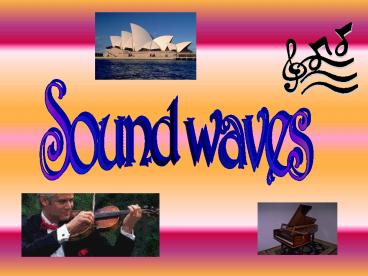Sound waves PowerPoint PPT Presentation
1 / 23
Title: Sound waves
1
Sound waves
2
The Way Sound Travels
- What type of wave is sound?
- longitudinal
- How does sound get from one place to another?
- By pushing/pulling air molecules.
- --compressions/rarefractions
- What determines the speed of sound?
- The medium its traveling in
- Red megaphone demo
3
The Way Sound Travels (cont.d)
- Where will sound travel fastest?
- Besides the medium, what other factor determines
how fast sound will travel? - The air temperature
Metal
Water
4
The Way Sound Travels (contd)
- What happens to the speed of sound as the
temperature increases? - The speed of sound increases
- At room temp 340 m/s
- At O C 331 m/s
- vsound 331 .6T
- Why does this phenomenon occur?
- Molecules move faster and have more collisions
as the temperature increases. - Will it travel in a vacuum?
- Absolutely not!
5
- What generates sound?
- Anything that vibrates!
- Tuning fork demo
- What are two ways that sound can be produced in
instruments? - Vibrating strings or columns of air (pipes)
- How can different notes be played on instruments?
- Change the length of the pipe or the tension
on the string!
6
FREQUENCY OF SOUND
- Microphone Demonstration
- What frequency can humans typically hear?
- 20-20,000 Hz
- What is the infrasonic range?
- Anything below 20 Hz
- What is the ultrasonic range?
- Anything above 20,000 Hz
7
Why We Hear Different Sounds
- What is a physics term used to describe the
different notes we hear? - Pitch!
- What wave characteristics do high pitched sounds
have? - They also have a high frequency and a
- short wavelength!
8
VOLUME
- What part of the wave corresponds to loudness?
- Amplitude
- What is loudness measured in?
- Decibels
- --above 120 is harmful
- --normal conversation is 60-70
- --storm is 90-110
- --concert is 100-125
9
- What did you notice about different instruments
playing the same note? - What did you notice about the waves produced from
each instrument? - What is the physics term that describes the
quality of sound? - Timbre
- Examples
- flute wave smooth, 1 frequency
- trumpet rigid couple of dominant
frequencies
10
CONSONANCE
- This occurs when a pleasant sound is produced by
waves that have frequency ratios that are whole
s. - For example
- middle C 264 Hz, high C 528 Hz
- a 21 ratio
- A fifth 32, a fourth 43,
- a third 54
- Ex) chords on a keyboard
11
DISSONANCE
- This is an unpleasant sound produced by
frequencies which do not have a whole number
ratio - For example, C C
12
Beat Frequency
- What is beat frequency and when does it occur?
- Box Demo
- It occurs from the interference of two waves and
an increase and decrease in amplitude are seen.
It can be seen well when two notes next to each
other are played.
13
- These occur in instruments like
the - trumpet
- There are multiple frequencies
which interact with each other to
produce the overall sound of the - instrument
OVERTONES
14
Fundamental Tone
- This is the lowest frequency produced by the
instrument which can produce resonance
15
Resonance
- Occurs when an object is forced to vibrate at its
natural frequency - When an object resonates, standing waves are
produced - Examples
- Wine glass
- Tacoma Narrows Bridge
- http//www.physics.bcit.ca/netshow/index.shtml
- http//www.camguys.com/bridgeclpse.html
- strobe light and elastic string
16
Standing Waves
- when the generated wave and reflected wave
produce one wave - contains nodes and antinodes
- nodeswhere the waves are out of phase with each
othercan be touched without disturbing the wave - antinodeswhere the waves meet in phase with each
other
17
Resonance in Instruments
- STRINGED INSTRUMENTS
- nodes at each end
- first harmonic is fundamental tone and is ½ the
wavelength being played - produces a harmonic at every ½ wavelength
- OPEN PIPES
- antinodes at each end
- first harmonic is ½ the wavelength played
- produces a harmonic each ½ wavelength
- PAN PIPE DEMO
18
SONG ONE
- 56517 556521 5553176 443121
19
SONG TWO
- 112712 334321 2171 55543
- 444432 34321345 64321
20
SONG THREE
- Top Melody
- Bottom Harmony
- 1155665 4433221 5544332
- 5533443 2211775 3322115
21
OLD MACDONALD
- MELODY
- 5 5 5 2 3 3 2 7 7 6 6 5 2
- Harmony
- 7 7 7 5 5 5 5 2 2 3 3 2 2
22
TWINKLE, TWINKLE LITTLE STAR
- MELODY
- 1 1 5 5 6 6 5 4 4 3 3 2 2 1 5 5 4 4 3 3 2
- 5 5 4 4 3 3 2 1 1 5 5 6 6 5 4 4 3 3 2 2 1
- HARMONY
- RR 3 3 4 4 3 1 1 1 1 2 2 1 R R 2 2 1 1 2
- R R 2 2 1 1 2 R R 3 3 4 4 3 1 1 1 1 2 2 1
23
- CLOSED PIPES
- a node at one end
- an antinode at the open end
- ¼ wavelength is the first harmonic
- the next harmonic is ½ wavelength, but cannot be
heard - the first overtone is ¾ wavlengths

